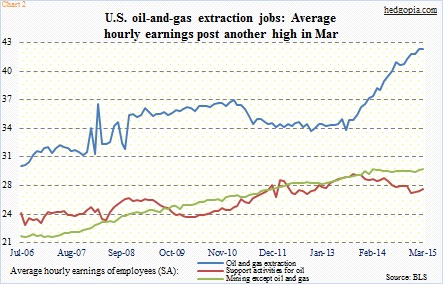U.S. oil-and-extraction jobs continued to drip lower, down 7.1k from the October 2014 high of 201.5k (down 3.5 percent by April). The curve is much steeper in support jobs, having lost 21.1k jobs from the September 2014 peak of 337.6k (down 6.3 percent by March).
Oil companies are not letting go of their engineers, etc. As well, support jobs saw a massive ramp in hiring beginning late 2009. From the low in October 2009 to the high last year, they surged 85 percent, while oil-and-extraction jobs increased 30 percent during the comparable period (Chart 1).
This phenomenon is reflected in the average hourly earnings. Oil-and-extraction jobs pay well; March was an all-time high of $42.32. They have experienced substantial increase the past two years. As early as July 2013, these jobs were paying $33.55. Support jobs peaked at $28.71 last September, and March was $27.15 (Chart 2).
After a big drop in energy job-cut announcements in March, April resumed the downward trend. So it is only natural to expect more losses in oil-related jobs in the coming months. If and when well-paid oil-and-extraction jobs begin to come under pressure, that in turn will put downward pressure on the private-sector average hourly earnings number that the markets, and the Fed, are so keenly focused on.

